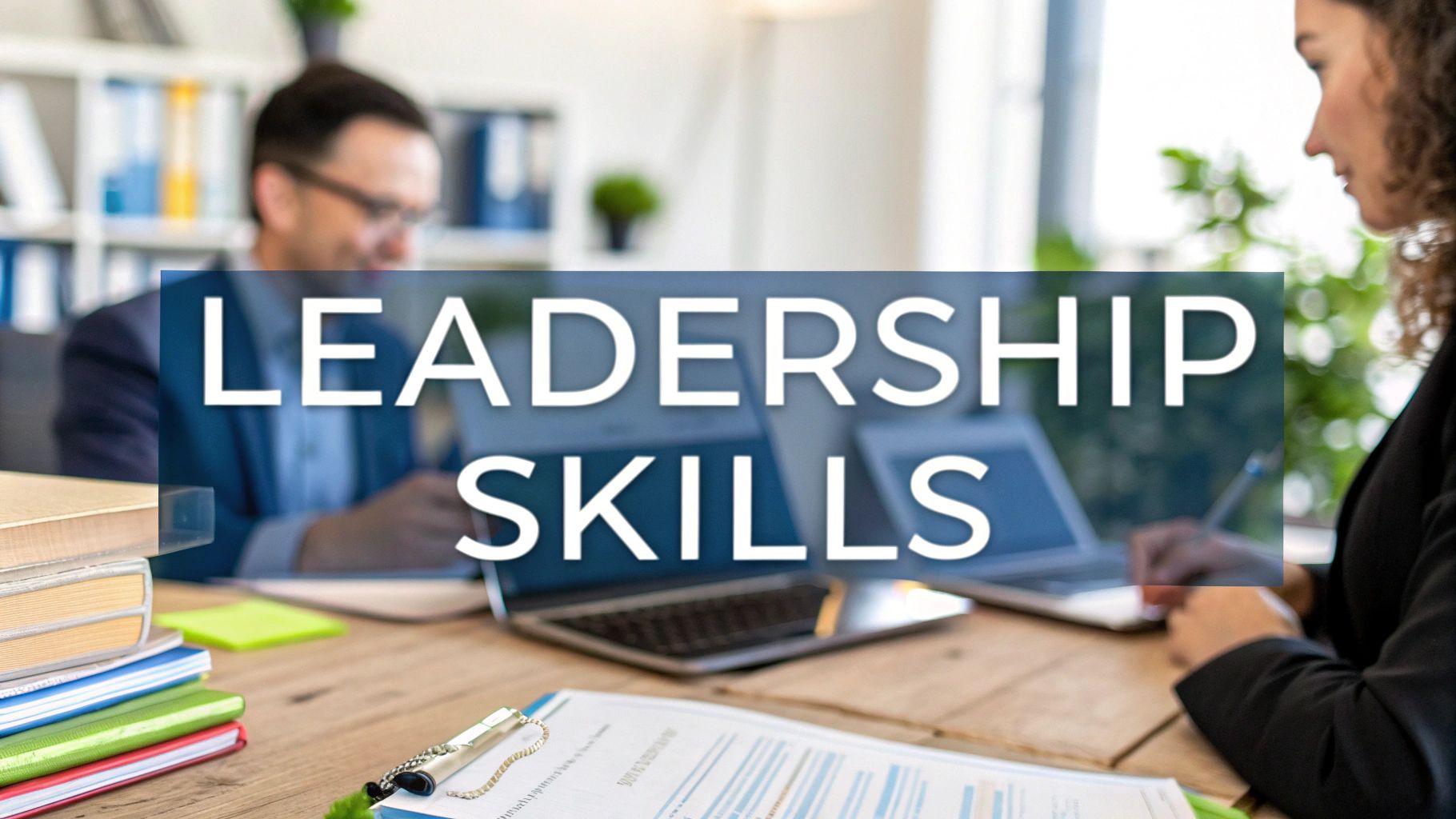Why Leadership Skills Matter More Than Ever

Leadership skills have become essential in today's workplace, regardless of your job title or position. Gone are the days when leadership was confined to those with corner offices or executive titles. The business world now recognizes that true leadership is about making an impact and influencing others positively, which anyone can do from any role. This shift means your leadership development matters tremendously, whether you're an entry-level employee or a seasoned manager.
The Expanding Impact of Leadership
Good leadership directly affects team performance, opens doors for career advancement, and contributes significantly to organizational success. When leaders listen actively and empower their team members, they create environments where people feel valued and motivated to perform. For instance, managers who recognize individual strengths and delegate accordingly often see higher productivity and innovation from their teams.
These skills don't just benefit the workplace—they create genuine career opportunities. Organizations are actively seeking employees who can lead initiatives, guide projects, and inspire colleagues. According to recent research, less than 5% of companies have implemented leadership training across all levels, despite clear evidence linking company-wide leadership development to better performance. For more statistics on this topic, check out Thomas Griffin's comprehensive leadership research.
Debunking Leadership Misconceptions
Many people wrongly assume leadership is all about charisma or authority. The reality is that effective leadership depends on practical skills like communication, thoughtful decision-making, and clear strategic thinking. These abilities don't magically appear—they develop through practice, feedback, and real-world experience.
Another common myth is that leadership only matters for people in management positions. This couldn't be further from the truth. Anyone can demonstrate leadership by taking initiative on projects, helping colleagues solve problems, or suggesting improvements to workplace processes. Leadership is about actions and attitude, not job titles or organizational charts.
The Competitive Edge of Leadership Development
Companies that prioritize leadership development consistently outperform their competitors. These forward-thinking organizations understand that building leadership capacity throughout their ranks creates a culture where innovation thrives and teams adapt quickly to challenges. This approach gives them a real edge in fast-changing markets.
When organizations invest in developing their people's leadership abilities, they signal their commitment to long-term growth rather than short-term gains. For individuals, focusing on leadership skills not only improves current job performance but also creates a foundation for lasting career success. Whether you're looking to advance your career or simply become more effective in your current role, leadership skills provide the tools you need to make a meaningful difference.
The Leadership Skills That Actually Drive Results
What makes a great leader? Beyond general concepts of "inspiration," concrete leadership skills truly drive team performance and organizational success. This section explores the specific capabilities that distinguish exceptional leaders from the rest, based on observations of high performers across various industries.
Identifying Crucial Leadership Skills
Great leadership builds on several fundamental abilities that work together to create positive outcomes:
- Communication: The ability to articulate ideas clearly, listen actively to understand others, and create an environment where open dialogue flourishes.
- Strategic Thinking: Looking beyond immediate challenges to spot emerging trends, analyze complex situations, and develop plans that support long-term goals.
- Decision-Making: Making sound judgments when facing pressure or uncertainty, evaluating available information effectively, and taking calculated risks when necessary.
- Identifying Talent: Spotting potential in team members and creating opportunities for their growth, which builds stronger teams and develops future leaders.
- Managing Change: Guiding teams through transitions and helping them adapt to new technologies, processes, or market conditions—particularly important in today's fast-changing business environment.
- Influencing Others: The capacity to persuade, motivate, and inspire people to take action toward common objectives.
These skills take different forms depending on your role and industry. For instance, a project manager's communication may focus on coordinating tasks, while a CEO's communication centers on sharing vision with stakeholders. One of leadership development's biggest challenges is closing gaps in these core abilities. Research shows that identifying talent, strategic thinking, managing change, decision-making, and influencing others rank as the top five leadership skills. For more detailed information, check out leadership statistics here.
Let's look at how these skills compare in different contexts:
Essential Leadership Skills Matrix
This table outlines the core leadership skills, their importance rating, and practical applications in different professional contexts.
| Leadership Skill | Importance Rating | Application Examples | Development Difficulty |
|---|---|---|---|
| Communication | Very High | Project updates, team meetings, client presentations, conflict resolution | Moderate |
| Strategic Thinking | High | Market analysis, long-term planning, competitive positioning | High |
| Decision-Making | Very High | Resource allocation, hiring choices, crisis management | High |
| Identifying Talent | High | Recruitment, performance reviews, succession planning | Moderate |
| Managing Change | High | Digital transformations, restructuring, process improvements | Very High |
| Influencing Others | Very High | Building consensus, selling ideas, motivating teams | High |
As this matrix shows, each leadership skill carries different weight depending on context, but all play a critical role in effective leadership. Communication and decision-making consistently rank highest in importance across most leadership positions.
Developing Your Leadership Skillset
Understanding these skills is just the first step—developing them requires dedicated effort and willingness to grow:
Seek Feedback: Regularly ask colleagues, mentors, and supervisors for input on your performance. Their observations can reveal blind spots you might miss and help you refine your approach.
Embrace Challenges: Growth happens outside your comfort zone. Take on new responsibilities that stretch your abilities, whether leading a project at work or volunteering for a leadership role in a community organization.
Continuous Learning: Leadership development never really ends. Stay current by reading books, attending workshops, or pursuing relevant certifications. Podcasts like The Covered Call offer real-world stories and practical advice from successful leaders.
Mentorship: Learning from experienced leaders can fast-track your development. A good mentor provides personalized guidance, shares valuable experiences, and offers perspective on navigating complex leadership challenges.
By focusing on these core skills and actively pursuing development opportunities, you build a strong foundation for effective leadership. This investment benefits not just your career but equips you to make a meaningful impact in your organization and beyond.
How Leadership Development Has Transformed

Leadership development has undergone remarkable changes in recent years. We've moved away from outdated command-and-control models toward approaches that recognize what truly makes leaders effective in today's workplace. Modern leadership development now places greater emphasis on collaboration, adaptability, and emotional intelligence – skills that were often overlooked in the past.
This shift didn't happen overnight. It's been driven by cultural changes, new technologies, and significant shifts in how our workplaces function. These forces have completely changed how organizations identify potential leaders and help them grow.
From Command to Collaboration
In the past, leadership typically meant top-down authority and strict hierarchies. The expectation was simple: leaders gave orders, and everyone else followed them. But this approach just doesn't work well anymore.
As early as the 1990s, forward-thinking institutions were already exploring new approaches. For example, Mansfield University's McKeever Institute focused on developing leadership potential in undergraduate women – a concept that was quite progressive for its time. You can read more about this program here.
Today's most successful leaders don't just direct – they build consensus, foster team collaboration, and empower people to contribute their best ideas.
The Role of Technology
Technology has completely changed how people develop leadership skills. Online platforms, virtual workshops, and interactive simulations now provide accessible learning experiences that weren't possible before.
These digital tools allow aspiring leaders to learn at their own pace and connect with experts from around the world. They can practice complex leadership skills in safe, virtual environments before applying them in high-stakes situations.
Data analytics and AI tools have also transformed leadership development by providing personalized feedback. Instead of generic programs, individuals can now receive specific insights about their unique strengths and growth areas, making development more targeted and effective.
Adapting to Change
Today's workplace never stands still. With globalization, remote work, and constant technological innovation, leaders must be incredibly adaptable and resilient.
This means leadership development now focuses heavily on building change management capabilities, problem-solving skills, and critical thinking abilities. The best programs incorporate real-world scenarios that prepare leaders for the complex challenges they'll face.
Modern leadership development also places much greater emphasis on emotional intelligence – the ability to understand and connect with diverse team members across cultures and backgrounds. Developing these interpersonal skills helps leaders navigate complexity and inspire their teams through uncertain times.
As our understanding of effective leadership continues to evolve, so too will the approaches we use to develop the next generation of leaders who can thrive in ever-changing environments.
Proven Tactics to Elevate Your Leadership Abilities

Let's get practical about leadership development. In this section, we'll move beyond theory and explore hands-on strategies that actually work in real-world settings. I've gathered these insights from conversations with successful executives and leadership coaches who've been in the trenches.
Creating Opportunities for Leadership Practice
You don't need a fancy title to develop leadership skills. The most effective growth happens through consistent practice in everyday situations. Look for chances to lead, even in small ways that might seem insignificant at first.
- Volunteer for Projects: Take on the responsibility of leading a project—any project. This gives you direct experience with planning, organizing teams, and keeping people motivated when challenges arise.
- Mentor a Colleague: Helping someone less experienced isn't just nice—it actively develops your coaching and communication abilities. These skills form the backbone of effective leadership.
- Facilitate Team Meetings: Step up to lead discussions, make sure everyone gets heard, and guide the group toward concrete outcomes. This shows your potential while building crucial skills.
- Propose Solutions to Challenges: When problems come up, be the person who brings ideas to fix them. This shows initiative and strategic thinking—qualities that get noticed.
Each of these actions gives you a chance to practice leadership in real situations, building both your confidence and capabilities without waiting for a promotion.
Leveraging Mentorship Effectively
Nothing accelerates leadership growth like having the right mentor. A good mentor offers personalized guidance based on their experience and helps you see situations from different angles. But the relationship only works if you approach it thoughtfully.
- Seek Out Mentors: Find people whose leadership approach you respect and who have demonstrated success. Reach out directly and explain why you'd value their guidance.
- Be Proactive: Come to mentorship meetings prepared with specific questions or situations you want to discuss. This shows respect for their time and makes the sessions more productive.
- Follow Through: Actually use the advice you receive. Report back on what happened when you applied their suggestions. This shows your commitment and strengthens your relationship.
Active engagement with mentors gives you access to hard-won insights that might otherwise take years to discover on your own.
Designing Personal Leadership Challenges
Growth happens outside your comfort zone. Creating deliberate challenges that stretch your capabilities is essential for developing as a leader. These should align with your specific goals and push you to try approaches you wouldn't naturally choose.
- Set SMART Goals: Define goals that are Specific, Measurable, Achievable, Relevant, and Time-bound. This creates a clear roadmap for your development and lets you track real progress.
- Seek Feedback Regularly: Ask colleagues, supervisors, and mentors for honest input about your performance. This reveals blind spots and helps you adjust your approach as needed.
- Reflect on Experiences: Take time to analyze what worked and what didn't in your leadership moments. Identify key lessons and apply them going forward. Podcasts like The Covered Call offer real-world stories from successful leaders that can provide valuable perspective.
The table below outlines a framework for implementing various leadership development activities based on your experience level and available time:
Leadership Development Activities Framework
This table presents various leadership development activities categorized by experience level, time commitment, and skill area impact
| Development Activity | Time Investment | Skill Areas Enhanced | Implementation Difficulty |
|---|---|---|---|
| Lead a small-scale project | 2-4 weeks | Decision-making, delegation, planning | Low |
| Mentor a junior colleague | 3-6 months | Communication, coaching, empathy | Medium |
| Facilitate department meetings | Ongoing (1-2 hours weekly) | Public speaking, conflict resolution | Low |
| Create process improvements | 1-2 months | Problem-solving, innovation, influence | Medium |
| Join cross-functional teams | 3+ months | Collaboration, strategic thinking | Medium |
| Volunteer for community leadership | Flexible | Community building, public relations | Low |
| Request stretch assignments | Varies | Adaptability, resilience | High |
| Lead crisis response | As needed | Decision-making under pressure, calm | High |
What turns an aspiring leader into an effective one isn't reading more books—it's consistent practice and pushing beyond what feels comfortable. By deliberately seeking growth opportunities, you'll develop the practical skills that truly matter when the pressure is on.
Breaking Through Leadership Development Barriers
Developing leadership skills requires dedication, yet obstacles often appear despite our best intentions. In this section, we'll address common roadblocks that can halt leadership growth and share practical solutions from experienced coaches and leaders who have helped thousands overcome these same challenges.
Limited Organizational Support
Many aspiring leaders struggle with a lack of formal development programs in their organizations. This can be discouraging, but it shouldn't stop your progress. Think of leadership development like learning a musical instrument – while formal lessons help, consistent practice makes the real difference.
- Create Your Own Opportunities: Look for projects, even small ones, where you can take the lead. These provide hands-on experience with planning, execution, and team coordination.
- Build a Network: Connect with other aspiring leaders both inside and outside your organization. Sharing experiences creates a powerful environment for growth – like forming your own informal "band" to practice together.
- Seek Mentorship Externally: If internal mentorship isn't available, find leaders in your field who can offer guidance. Podcasts like The Covered Call give you access to insights from experienced leaders.
This proactive approach lets you grow your leadership skills regardless of what your organization offers.
Handling Constructive Feedback
Receiving feedback can feel uncomfortable, especially when it highlights areas for improvement. Yet embracing feedback is crucial for growth. Think of it as a coach's guidance – tough to hear at first, but ultimately improving your performance.
- Be Open to Criticism: See feedback not as a personal attack but as a learning opportunity to refine your skills.
- Ask Clarifying Questions: Don't hesitate to seek more explanation if feedback seems unclear or too general. The better you understand it, the more effectively you can use it.
- Focus on Actionable Steps: Rather than dwelling on criticism, identify specific changes you can make based on what you've heard.
By actively processing feedback, you transform potential discomfort into a catalyst for improvement.
Maintaining Momentum Amid Competing Priorities
Between daily tasks, deadlines, and family commitments, finding time for leadership development can be challenging. It's similar to maintaining a regular exercise routine while juggling a demanding work schedule and personal life – it requires intention and strategy.
- Schedule Dedicated Time: Block specific slots in your calendar for leadership growth activities, whether reading, listening to podcasts, or practicing specific skills. Treat these appointments as seriously as any important meeting.
- Integrate Development into Daily Work: Look for chances to practice skills like communication and delegation in your current role. These small daily "workouts" significantly contribute to your leadership "fitness."
- Set Realistic Goals: Break large leadership development goals into smaller, achievable steps. This prevents overwhelm and makes consistent progress more manageable.
By approaching leadership development with strategy and persistence, you can overcome these common barriers even when things get tough. You'll gain not just practical skills but also the resilience and determination that effective leadership demands.
Tracking Your Leadership Evolution

How can you tell if your leadership skills are actually improving? Rather than relying on gut feelings, this section explores concrete ways to measure real progress in your leadership journey. By applying measurement techniques used by top executives, you'll gain clear insights into your development and create a roadmap for continued growth.
Establishing Your Leadership Baseline
Think of leadership development like learning a musical instrument - you need to hear yourself play before you can improve. Creating an honest assessment of your current abilities in areas like communication, decision-making, and team management gives you something concrete to measure against.
Your baseline isn't about harsh self-judgment but clear self-awareness. Maybe you notice you excel at one-on-one conversations but struggle when presenting to groups. Or perhaps you make solid decisions under normal conditions but falter under pressure. Identifying these patterns helps you focus your development efforts where they'll have the greatest impact.
Gathering Feedback for a 360-Degree View
Looking in the mirror only shows you one angle. To see the full picture of your leadership impact, you need perspectives from the people around you. 360-degree feedback from colleagues, team members, and supervisors reveals blind spots you'd never catch on your own.
Getting helpful feedback requires creating the right environment. When you ask for input, make it clear you're genuinely seeking growth opportunities, not fishing for compliments. Simple questions like "What's one thing I could do differently in our meetings?" often yield more honest responses than vague requests for "feedback."
Using Quantitative and Qualitative Indicators
Measuring leadership growth combines hard numbers and rich descriptions. Quantitative measures might include team retention rates, project success percentages, or how frequently your ideas get implemented. These numbers tell you if you're moving in the right direction.
The qualitative side adds depth and context. Your personal journal entries about how you handled a difficult conversation, notes from a mentor about changes they've observed, or your own reflections on how you're responding differently to challenges - these insights help you understand not just what's changing but why. This deeper understanding lets you fine-tune your approach as you go.
Celebrating Milestones and Recognizing Incremental Growth
Leadership development isn't a quick sprint but a lifelong marathon. Acknowledging both major achievements and small wins keeps you motivated for the journey. Maybe you finally mastered that difficult conversation you'd been avoiding, or a team member mentioned they felt more supported by your new approach.
These small victories deserve recognition. They build momentum and remind you that meaningful change happens gradually. By tracking both your big breakthroughs and subtle shifts, you transform leadership development from a vague aspiration into something you can see, measure, and celebrate along the way.
Ready to hear from leaders who've walked this path before you? Check out The Covered Call Podcast for real conversations with accomplished leaders who share their personal journeys, mistakes, and breakthroughs. Their stories might be exactly what you need to take your next step forward.

